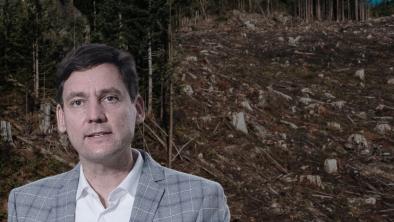Trail building through West Coast ancient rainforest
Westerly News

Summer was a busy time for members and volunteers with the Wilderness Committee (WC) who spent time building and maintaining trails in both Meares Island and the Clayoquot River Valley (CRV).
Trail construction and upkeep is labourous work, but has its rewards, according to Sven Biggs, outreach and membership assistant with the WC.
"There's a couple trails we're working on, on Meares Island," Biggs told the Westerly. "There's Big Tree Trail for ages six and up; and the Lone Cone Trail, which is a little more ambitious."
The trails on Meares Island are already established, but require upkeep, according to Biggs, who has worked with the committee for several years and makes trips to the West Coast every summer.
"Most of the year I sit behind a desk with a computer," he said. "It's a good change, and it's great to make sure people can visit this area."
He said a crew worked in the CRV until September 6.
"It's for anybody who has gone into the back country," Biggs said. "There's obviously a work component, but it's fun work."
He said the CRV is a difficult hike out, which takes time, stamina and a lot of effort.
"By the end it's pretty exhausting," he said. "But the whole time you're there you're being close to these big trees."
"We're inspired as well as exhausted."
The WC's national campaign director, Joe Foy, agreed and said the CRV is one of the toughest places to build a trail.
"It's a fairly hard hike for two days and you have to go fairly deep into the valley," he explained.
He said people who want to build trails should be in good shape and be prepared to work long days.
Andy Miller, a staff scientist with the committee, wrote in his blog that wolves and what felt like monsoon weather greeted the summer's first group of trail-builders in the valley.
"Scenery of alpine lakes, vast expanses of polished marble, a small but bright fire and good cave cheer more than made [up] for the damp trail-building," Miller wrote.
He said of the 100 big and wild valleys on the West Coast of Vancouver Island, less than a dozen remain untouched--one being the CRV.
The work is being done in conjunction with Tla-o-qui-aht First Nation Tribal Parks.
"The trail, first built by [Wilderness Committee] trail-builders in the 1990s helped to temporarily save this magnificent valley," he wrote. "Now it is close to becoming a [TFN] Tribal Park so we are sprucing up the trail once again."
For more information visit www.wildernesscommittee.org
Photo credit: Old growth Sitka spruce tree in Clayoquot River Valley - Wilderness Committee


